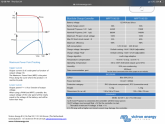I have 4 24volt nominal 305watt panels
I am curious what happens if I connect 2series 3parallel to a charge controller rated for 100volts and 50amps?
with 2 of these panels in series that's around 80volts open circuit. Well below 100v of the charge controller.
Under ideal conditions I get 1830 watts from 6 panels.
When the charge controller converts 1830 watts to 24V to charge my battery, it could potentially create 76 amps of current. Will this damage or destroy the charge controller?
What I am hoping is that I can gain more power on cloudy days and when in full sun the extra power will just be lost(but not destroy my charge controller)
This is theoretical in case I want to upgrade slightly in the future without the expense of a new charge controller. Simply adding 2 more panels to the 4 I have to go from 1220 to 1830 watts is a cheaper way to get a boost than to have to invest in higher voltage battery bank or buy additional charge controllers
Is this safe?
I guess I should add that I am using a Victron BlueSolar 100/50, so the quality should be pretty good.
I am curious what happens if I connect 2series 3parallel to a charge controller rated for 100volts and 50amps?
with 2 of these panels in series that's around 80volts open circuit. Well below 100v of the charge controller.
Under ideal conditions I get 1830 watts from 6 panels.
When the charge controller converts 1830 watts to 24V to charge my battery, it could potentially create 76 amps of current. Will this damage or destroy the charge controller?
What I am hoping is that I can gain more power on cloudy days and when in full sun the extra power will just be lost(but not destroy my charge controller)
This is theoretical in case I want to upgrade slightly in the future without the expense of a new charge controller. Simply adding 2 more panels to the 4 I have to go from 1220 to 1830 watts is a cheaper way to get a boost than to have to invest in higher voltage battery bank or buy additional charge controllers
Is this safe?
I guess I should add that I am using a Victron BlueSolar 100/50, so the quality should be pretty good.



